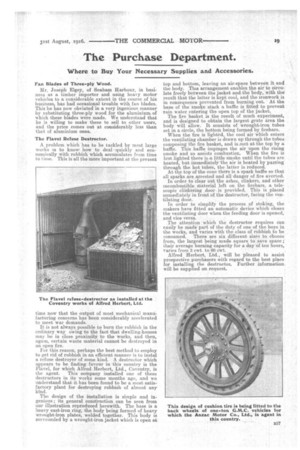The Purchase Department.
Page 23

If you've noticed an error in this article please click here to report it so we can fix it.
Where to Buy Your Necessary Supplies and Accessories.
Fan Blades of Three.-ply Wood.
Mr. Joseph Elgey, of Seaham Harbour, in business as a timber importer and using heavy motor vehicles to a considerable extent in the course of his business, has had occasional trouble with fan blades. This he has now obviated in a very ingenious manner by substituting three-ply wood for the aluminium, of which these blades were made. We understand that he is willing to make these to sell to other users, and the price comes out at considerably less than that of aluminium ones.
The Flavel Refuse Destructor.
A problem which has to be tackled by most large works is to know! how to deal quickly and economically with rubbish Which accumulates from time to time. This is all the more important at the present time now that the output of most mechanical manufacturing concerns has been considerably accelerated to meet war demands.
It is not always possible to burn the rubbish in the ordinary way. owing to the fact that dwelling-houses may be in close proximity to the works, and then, again, certain waste material cannot be destroyed in an open fire.
For this reason, perhaps the best method to employ to get rid of rubbish in an efficient manner is to instal a refuse destroyer of some kind. A destructor which appears to be finding favour in this country is the Flavel, for which Alfred Herbert, Ltd., Coventry, is the agent. This company installed one of these destructors in its works some months ago, and we understand that it has been found to be a most satisfactory plant for destroying rubbish of almost any kind.
The design of the installation is simple and ingenious; its general construction can be seen from our illustration reproduced herewith. The base is a heavy cast-iron ring, the body being formed of heavy wrought-iron plates, welded together. This body is surrounded by a wrought-iron jacket which is open at
top and bottom, leaving an air-space between it and the body. This arrangement enables the air to circulate freely between the jacket and the body, with the result that the latter is kept cool, and the ironwork is in consequence prevented from burning out. At the base of the smoke stack a baffle is fitted to prevent rain water entering the open top of the jacket. The fire basket is the result of much experiment, and is designed to obtain the largest grate area the body will allow. It consists of wrought-iron tubes set in a circle, the bottom being formed by firebars. When the fire is lighted, the cool air which enters the ventilating chamber is drawn up through the tubes composing the fire basket, and is.rnet at the top by a. bailie. This baffle impinges the air upon the rising smoke and so assists combustion. When the fire is first lighted there is a little smoke until the tubes are heated, but immediately the air is heated by passing through. the hot tubes, the latter is reduced. At the top of the cone there is a spark bailie so that all sparks are arrested and all danger of fire averted. In order to clear out the ashes, clinkers, and other incombustible material left on the firebars, a telescopic clinkering door is provided. This is placed immediately in front of the destructor, facing the ventilating door. In order to simplify the process of stoking, the makers have fitted an automatic device which closes the ventilating door when the feeding door is opened, and vice versa.
The attention which the destructor requires can easily be made part of the duty of one of the boys in the works, and varies -with the class of rubbish to be consumed. There are six different sizes to choose from, the largest being made square to save space ; their average burning capacity for a day of ten hours, varies from 3 cwt. to (30 cwt.
Alfred Herbert, Ltd., will be pleased to assist prospective purchasers with regard to the best place for installing the destructor. Further information will be supplied on request.
























